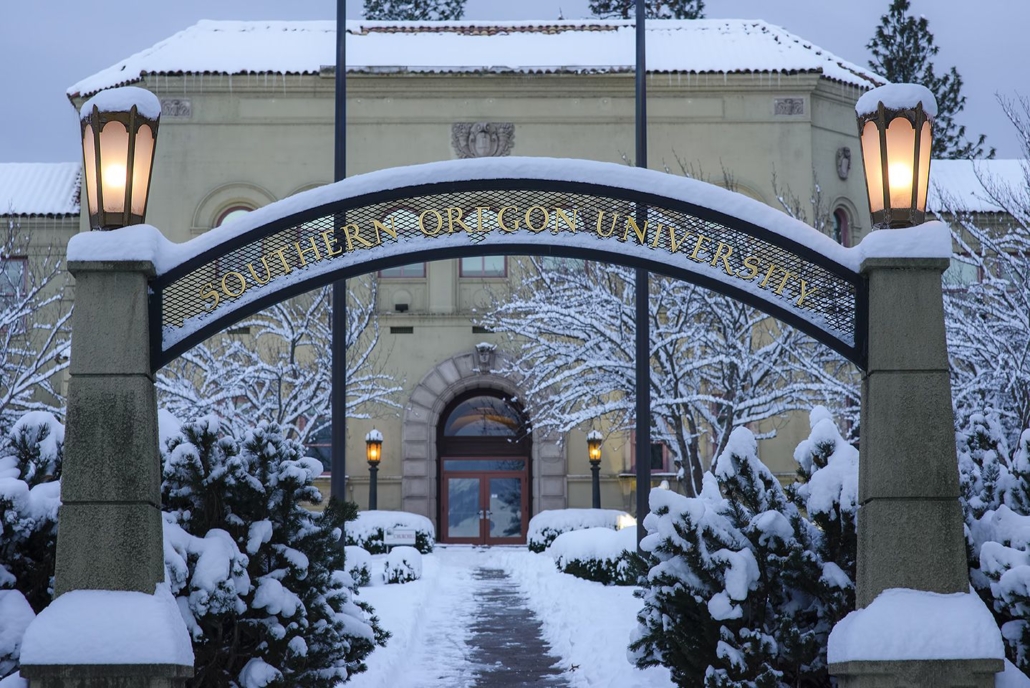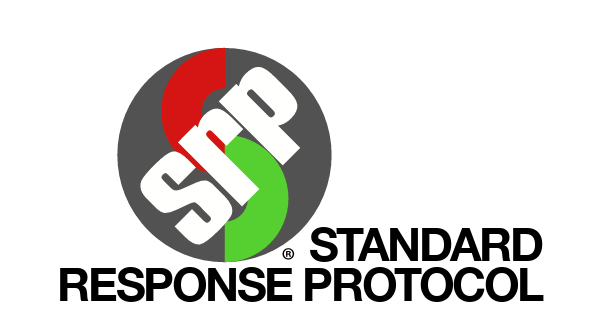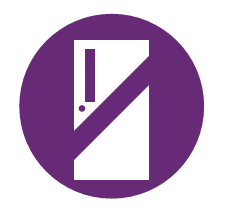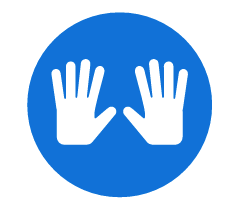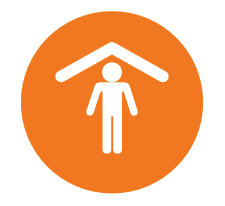Human Resources
Check SOU Alerts. In the case of an emergency, this mass notification system quickly sends alerts through email, phone, and text messaging. Every effort will be made to communicate a closure as early as possible but not later than 6:30 a.m. Supervisors may also contact their staff directly and prior to the start of their shift in the event of a closure or delayed start.
Check the SOU website at www.sou.edu, or contact 541-552-7672 (Ashland Campus) and 541-552-8100 (Medford Campus).
Tune in and listen to the following radio and TV stations to stay on top of the situation:
| Ashland | KSOR | KSMF | |
| Ashland to Gold Hill | KSJK | KSRG | |
| Grants Pass | KAJO KLDR |
KAGI | KSMF |
| Klamath Falls | KLAD AM/FM KSKF KFEG KNYR |
KKKJ KFLS KYSF |
KLMF KKRB KAGO AM/FM |
| Medford | KCMX AM/FM KOOL KAKT KOBI TV KSYS TV |
KRWQ KBOY KMED KTVL TV |
KISS KTMT KZZE KDRV TV |
| Yreka | KSYC AM/FM | KWHO | KNSQ |
- University employees deemed by their supervisor as critical to providing on-campus essential services must continue to report to onsite work during the closure or curtailment (e.g. Campus Public Safety officers, dining services personnel, select Facilities Management and Planning staff, select Information Technology staff, etc.). When reporting to campus for work, employees are expected to use their best judgment in assessing the risk of coming to campus based on individual circumstances.
- All employees with a telecommuting arrangement or employees who have the resources required to perform their jobs should work remotely at their regular rate of pay or request and receive approval from their supervisor to use appropriate accrued leave (e.g. vacation, compensatory time off, personal day, etc.). In the event that inclement weather disrupts one’s ability to perform their work remotely, they should contact their supervisor to discuss the circumstances and devise a plan accordingly (i.e. flex work shift, etc.).
- Classified staff not identified above and who are unable to perform their work remotely shall be allowed to access inclement weather leave in accordance with the SEIU collective bargaining agreement and must designate it on the official leave record/timesheet in Workday.
- Unclassified administrative non-exempt staff and student employees not identified above and who are unable to perform their work remotely, do not receive compensation unless the application of available and eligible accrued leave is applied or the University President deems the closure as paid. Supervisors are encouraged to plan in advance and consider the following where applicable:
- Remote Work Assignments: This is a great time to get standard operating procedures created or edited, handwritten team notes typed up, work schedules projected, web content enhanced, in-house training guides updated, business process guides developed, virtual meetings tended to, and professional development training completed (i.e. LinkedIn Learning courses).
- Make-up Hours: The unclassified administrative non-exempt staff and student employee pay periods are from the 13th – 12th of each month. Supervisors may authorize extra work hours (remote or onsite) to help keep paychecks whole. Please note that our Student Employment Handbook – Maximum Hours of Employment states, “Student Employees are students first and foremost and, in recognition of this, are limited to working a maximum of 20 hours per week (total for all departments) during any week in which regular classes are scheduled. A student employed with more than one department needs to coordinate their schedule with both areas so as not to exceed the 20-hour-per-week maximum. In emergency situations that require the specialized skills of a Student Employee, it is permissible for a Student Employee to work up to 30 hours per week for a limited duration. The supervisor must provide written rationale for this exception and obtain approval from the Human Resource Services before the Student Employee works the additional hours. Due to federal work-study and visa requirements for international students, these positions may not work more than 20 hours per week, no exceptions.”
- All employees already on approved leave (e.g. vacation, personal day, sick, etc.) shall continue to record this time in Workday accordingly.
Understand the Temporary Closure or Curtailment of University Services Policy.
Review the Use of Leave During Campus Closures (including delayed openings) for clarification on paid inclement weather leave and when essential classified staff could request pay at a rate of double time-and-one-half (inclement weather leave + 1.5 times pay for the 2.5 rate).
Resources
We would like to offer these Safety Preparedness Resources to assist in your wellbeing and safety while on campus.
1: Jackson County Emergency Management Alerts: All Hazards notifications. Jackson Alerts sign up:

2: ![]() SOU Regroup
SOU Regroup
Located in your Inside SOU/ OKTA app page, this messaging will include weather related delays and closures, on-campus risks and emergencies, and instructions. Your SOU email is automatically enrolled for messaging when you register for classes. Please be sure to verify your information and add your cell phone number for messages.
3: ![]() Watch Duty App: Cost: Free for basic service
Watch Duty App: Cost: Free for basic service
Fire-only notifications. Non-profit organization using public information provided by public admins. Info may not be verified by emergency services.
4: ![]() Genasys Protect App: Cost: Free
Genasys Protect App: Cost: Free
Evacuation zone notifications, “Know your Zone”.
Privately owned/ managed. Notifications may be delayed compared to Jackson Alerts.
Southern Oregon University spans 2 evacuation zones: Zone 3 which lies South of Siskiyou Boulevard and includes the core campus and classroom buildings as well as Madrone Residence Hall, and Zone 7, which encompasses the North Campus Village, (Residence Halls, Lithia Motors Pavilion, the Hawk dining hall, Raider Stadium, and Student and Family Housing. (SEE MAPS ATTACHED)
5: Text-Only alerts from City of Ashland (NOT county-wide)
Text 97520 to 888777 (for county-wide notifications, text JACKSONEVACS to 888777)
Tip: Add 888777 to your phone contacts as “JACKSON ALERTS” and assign it a unique alert tone, even when your phone is on silent.
In an emergency, call 911. For any other calls for service, call 541-552-6911 and press 6 to reach a dispatcher.
Exit Routes
Student Safety
A critical ingredient in the safe campus recipe is the uniform response to an incident. Weather events, fires, accidents, intruders, and other threats to student and staff safety are scenarios that are planned and trained for by campus administration.
The Standard Response Protocol
The Standard Response Protocol (SRP) is based on an all-hazards approach as opposed to individual scenarios. Like the Incident Command System (ICS), SRP utilizes a clear common language while allowing for flexibility in protocol.
Our campus is expanding the safety program to include the SRP, which is based on these five actions: Lockout, Lockdown, Evacuate, and Shelter. In the event of an emergency, the action and appropriate direction will be called on the public address system and delivered to your campus safety application.
Timely notification is essential in any type of crisis. Please verify that your contact information is current in the campus notification system.
 © Copyright 2020, All Rights Reserved. The “I Love U Guys” Foundation. Conifer, CO. The Standard Response Protocol and Logo are Trademarks of The “I Love U Guys” Foundation and may be registered in certain jurisdictions. This material may be duplicated for distribu- tion per “SRP Terms of Use”. SRP HED Student Staff Handout | V 3.0 | Revised: 06/25/2020 | http://iloveuguys.org
© Copyright 2020, All Rights Reserved. The “I Love U Guys” Foundation. Conifer, CO. The Standard Response Protocol and Logo are Trademarks of The “I Love U Guys” Foundation and may be registered in certain jurisdictions. This material may be duplicated for distribu- tion per “SRP Terms of Use”. SRP HED Student Staff Handout | V 3.0 | Revised: 06/25/2020 | http://iloveuguys.org
Hold
“In Your room or Area”
Hold is called when halls or common areas need to be temporarily cleared.
Students:
- Clear the hallways and remain in your area or room until all clear is announced
- Do business as usual
Instructors and Staff:
- Recover people from the hallway
- Lock classroom door
- Account for students, visitors and others
- Do business as usual
Secure
“Get Inside. lock outside doors”
Secure is called when there is a threat or hazard outside the building.
Students:
- Return to inside of building
- Do business as usual
Instructors and Staff:
- Recover students, visitors and staff from outside building
- Lock exterior doors
- Increase situational awareness
- Account for students, visitors and others
- Do business as usual
Lockdown
“locks, lights, out of Sight”
Lockdown is called when there is a threat or hazard inside the building.
Students:
- Move away from sight
- Maintain silence
- Prepare to evade or defend
Instructors and Staff:
- Recover people from hallway if it is safe to do so
- Lock classroom door
- Lights out
- Move away from sight
- Maintain silence
- Do not open the door
- Prepare to evade or defend
Evacuate
“To a location”
Evacuate is called to move people from one location to another.
Students:
- Leave stuff behind if required to
- If possible, bring your phone
- Show your hands
- Be prepared for alternative instructions
Instructors and Staff:
- Bring roll sheet and Go Bag (unless instructed not to take anything with them, dependent on reason for evacuation.)
- Lead students to evacuation location
- Account for students, visitors and others
- Report injuries or problems to first responders using Red Card / Green Card method.
Shelter
“State Hazard and Safety Strategy”
Shelter is called when the need for personal protection is necessary.
Hazards might include:
- Tornado
- Hazmat
- Earthquake
- Tsunami
Safety Strategies might include:
- Evacuate to shelter area
- Seal the room
- Drop, cover and hold
- Get to high ground
Students:
- Use appropriate safety strategies for the hazard
Instructors and Staff:
-
- Lead appropriate safety strategies for the hazard
- Account for students, visitors and others
- Report injuries or problems to first responders using Red Card / Green Card method.
Become familiar with the Wildfire Smoke Policy and keep up on air quality levels at https://aqi.oregon.gov/. Wildfires can be a significant source of air pollution in the area and can pose a major health risk. With the foliage that is present in our region, wildfires can occur and create an air quality hazard. The smoke from a wildfire compounding with the topographic nature of the area creates a bowl effect with the surrounding hills that prevents effective air movement. Smoke is made up of primarily small particles, gases, and water vapor, with trace amounts of hazardous air pollutants. The most harmful are the small particles, or particulate matter smaller than 2.5 micrometers in diameter. These particles can be inhaled deeply into the lungs, damaging lung tissue, and causing respiratory and/or cardiovascular problems. Symptoms from short-term smoke exposure can range from scratchy throat, cough, irritated sinuses, headaches, runny nose, and stinging eyes. Persons with asthma, emphysema, congestive heart disease, and other existing medical conditions can have more serious reactions.
Churchill Hall 159
1250 Siskiyou Boulevard
Ashland, OR 97520
Email: hrs@sou.edu
Phone: (541) 552-8553
Fax: (541) 552-8508
Hours: Monday-Friday, 8:00 a.m. – 5:00 p.m. [excluding university holidays]
Request an Appointment

